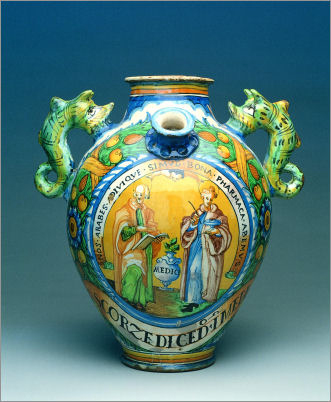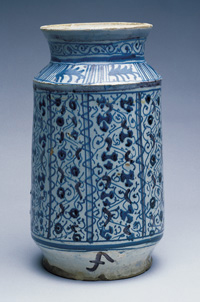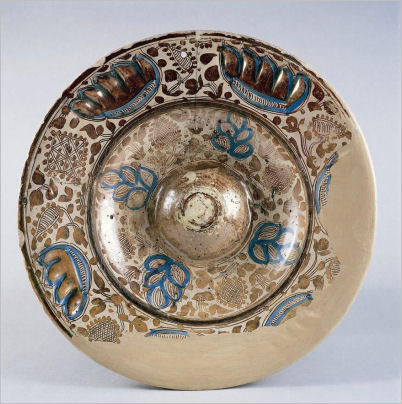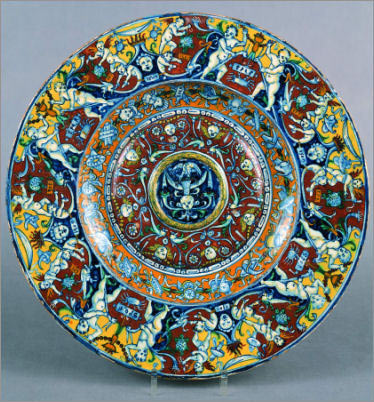 If you are planning a trip to Italy, make sure to include in your itinerary a visit to the city of Montelupo and its new Museum of Ceramics. You will not regret it. It will offer you a charming glimpse of the beautiful countryside just east of Florence and the thrill of being confronted with one of the most important Tuscan ceramic collections in the world.
If you are planning a trip to Italy, make sure to include in your itinerary a visit to the city of Montelupo and its new Museum of Ceramics. You will not regret it. It will offer you a charming glimpse of the beautiful countryside just east of Florence and the thrill of being confronted with one of the most important Tuscan ceramic collections in the world.
Montelupo… you may not be familiar with the name, but you certainly are with its ceramics, which are mostly known in the US as Tuscan ceramics, Florentine majolica, Florence pottery.
As a matter of fact, from the 15th to the 17th century Montelupo was one of the most important ceramic centres in Italy and all the functional and decorative pottery ordered in Florence was made there.
The role played by Montelupo pottery in the history of Italian ceramics was re-defined only a few years ago, thanks to the unexpected discovery of an old well full of kiln shards. This is the reason why the name of this quiet, charming village is not as well known as it deserves to be and why you should not miss a visit to its Museum!
Housed in a newly renovated building, the Museum opened its doors on May 24th, 2008 under the direction of Fausto Berti, a notable historian and archeologist, who has been in charge of the archeological excavations in Montelupo since 1982.
Keep your expectations high
 What makes the Museum so definitely worth a visit is the uniqueness of its large collection of ceramic works. Most of the 5,500 pieces belonging to the collection come from the excavations made in the area of Montelupo in the last 33 years. They provide an extraordinary opportunity to travel back in time through five centuries in the history of one of the most important ceramic centres in Europe.
What makes the Museum so definitely worth a visit is the uniqueness of its large collection of ceramic works. Most of the 5,500 pieces belonging to the collection come from the excavations made in the area of Montelupo in the last 33 years. They provide an extraordinary opportunity to travel back in time through five centuries in the history of one of the most important ceramic centres in Europe.
The 1,200 works on permanent display – 400 never on view before – date back from between the 13th to the 18th century. The excavations in the archeological sites around Montelupo continuously provide the Museum with new relevant material, promptly integrated into its dynamic collection.
The odd story of the Museum of Montelupo Ceramics
Montelupo has been considered for a very long time a minor pottery production centre, mostly active in the 17th century, a period of decline in the history of ceramics after the vibrant artistic vitality of the Renaissance.
In 1973 the unexpected discovery of an old water well full to the brim of kiln shards in the Castle area and the ensuing publishing of a book about the finding by Galeazzo Cora re-defined forever the role of Montelupo in the history of Tuscan ceramics.
Hundreds of ceramic pieces from the Renaissance were found in the excavations thanks to the hard work of an Association of Volunteers. At the same time, a Restoration Laboratory was set up to restore the magnificent ceramic pieces that have never stopped emerging from the ancient kiln sites.
In the eighties, Montelupo Administration decided to give a good home to their precious majolicas and founded the Museum of Montelupo Ceramics in the old Palazzo del Podestà. The steady growth of the collection in quantity and quality in the last 20 years has forced the management to move into a more spacious building.
The history of Montelupo pottery through the Museum collection
The journey through the history of Montelupo pottery begins in the 13th century with some simply molded pieces decorated with green and brown glazes, known as archaic pottery.
At this time ceramics were merely functional and the time “wasted” in decorating each piece was compensated by a quicker sale.
After 1360 favourable economic conditions stimulated the production of a more refined type of pottery and Montelupo and the near village, Bacchereto, became the driving force of the renovation and success of Florentine pottery.
In 1406 Florence subdued the city of Pisa and won quick access to the sea through the Arno river, from then on the most important trade route for the pro-active Florentine merchants.
Montelupo is right there, along the Arno, not far from Florence. In addition to providing first rate clay, the river multiplied the trading opportunities of the local potters who became the official suppliers to Florentine nobility and wealthy merchants.
Their production at the beginning of the 15th century  is very much influenced by the Muslim and Hispano-Moresque ceramics. Montelupo potters knew this was the kind of pottery people were crazy about all over the Mediterranean region. They set about learning its techniques and the secrets of its glazes. Their production was so good that in a short time they became direct competitors of their fellow potters from Valencia and Manises.
is very much influenced by the Muslim and Hispano-Moresque ceramics. Montelupo potters knew this was the kind of pottery people were crazy about all over the Mediterranean region. They set about learning its techniques and the secrets of its glazes. Their production was so good that in a short time they became direct competitors of their fellow potters from Valencia and Manises.
Although some of the typical attributes of the Hispano-Moresque pottery were soon overcome by the local vital creativity, some others still survive in the heritage of Montelupo pottery, like the cobalt blue decorations and vine leaf designs.
By the end of the 15th century, Montelupo ceramics had  developed their own
developed their own
original identity and had completely absorbed the Renaissance values. Very elaborate figurative subjects replaced the ornamental motifs of the previous decades and, together with the use of a much wider colour palette, they became the dominant features of Montelupo pottery Golden Age.
The most well known families from Florence commissioned large dinnerware sets with their coats of arms to their favourite potters in Montelupo or asked for “porcelain style” tableware meant to stand comparison with the popular Chinaware imported from the Far East. Lorenzo the Magnificient himself – considered the patron of the Renaissance Art – collected some fine decorative ceramics from Montelupo.
The contribution of Florence to the success of Montelupo pottery was not limited to the expensive purchases made for the local households. A constant flow of investments coming from wealthy Florentine merchants drove the exportation of ceramics all over the world.
An example: in 1490, Francesco Antinori, the owner of one of the largest export companies in Florence specializing in Montelupo ceramics, made an agreement with 23 potters in Montelupo and bought their production for 3 years to come.
The Museum houses a splendid collection of Renaissance majolica, which includes a large basin that is unanimously considered one the masterpieces of Italian Renaissance Art: the Rosso from Montelupo (1509) by Lorenzo di Piero Sartori.
splendid collection of Renaissance majolica, which includes a large basin that is unanimously considered one the masterpieces of Italian Renaissance Art: the Rosso from Montelupo (1509) by Lorenzo di Piero Sartori.
Its name – Rosso meaning Red – is due to the unique red glaze used for its decoration, whose recipe is still unknown to date.
The potters from Montelupo didn’t seem to suffer from the approaching economic decline in the second half of the 16th century. They kept receiving large orders from Florence, like the floor tiles commissioned by Maria de’ Medici for the Luxembourg Palace in Paris and Palazzo Pitti in Florence.
The production of Italian ceramics steadily declined during the 17th century and Montelupo pottery was no exception.
However the tradition and the ceramic art have revived, today thanks to the enthusiasm and the talent of a number of artists and the best efforts of the local municipality.
Museum of Montelupo Ceramics
Tue/Sun: 10.00/18.00
Tel. 0039 0571 51352
info@museomontelupo.it

I have two pieces of art I have aquired.I know it is from montelupe and one art piece is 589 nryf 501-600- vh/s/4 and the other is 51-142032b/bu/2 white bowl if you any information on these pieces please contact me.
i just wanted to say that I love this site
I was recently given a dinnerware set from my mother, it is a set of antique Deruta, and it was given to my grandmother in the 1940’s while she was a missionary in Italy. Some of the peices say Deruta but others just have a rooster as the signature. I am trying to find out the value of all these pieces, please contact me. 843-899-5696 in South Carolina. Thanks. Brandy Atkins